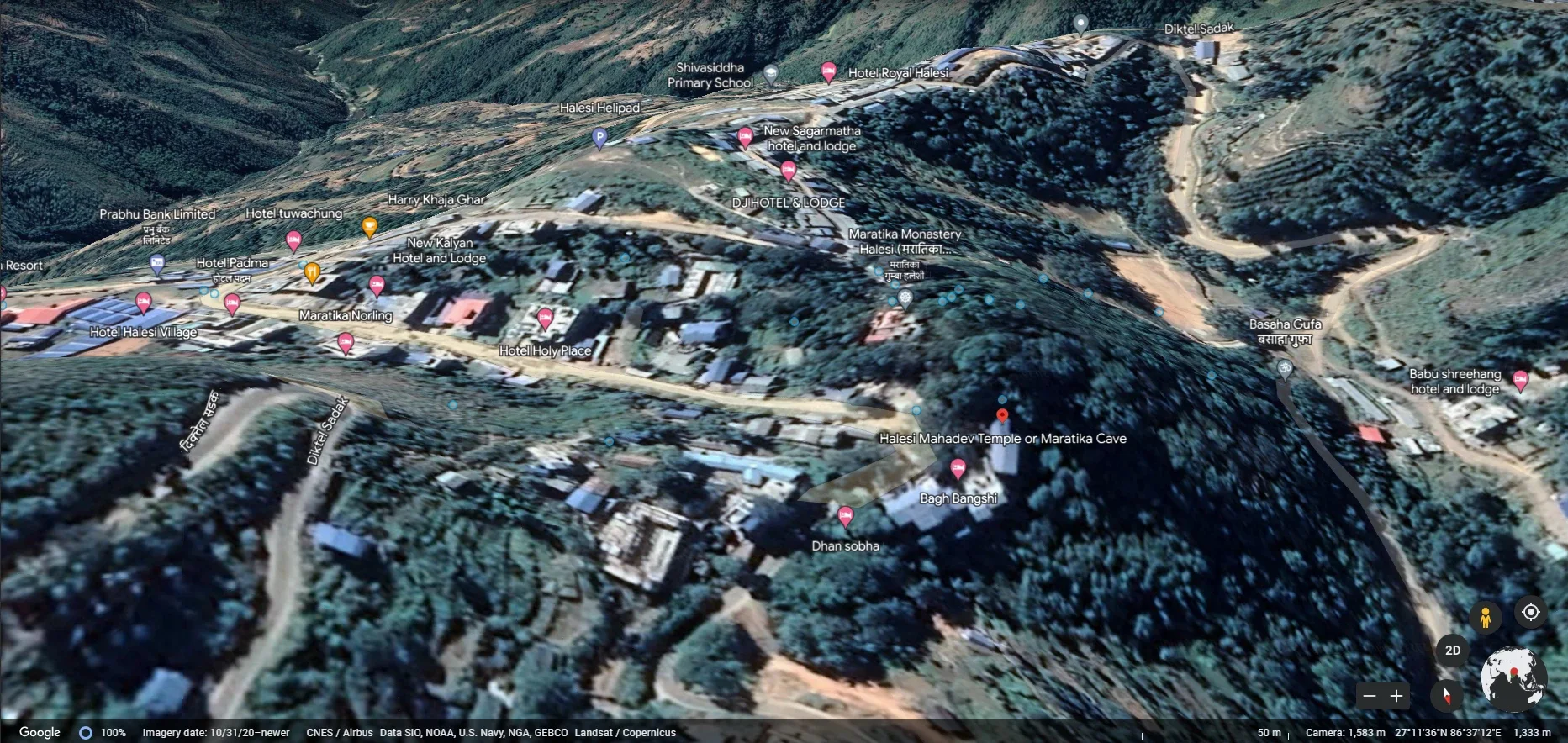Khotang Halesi Mahadev Temple- A pligrimage place
Synopsis: The Halesi Mahadev temple, nestled in Nepal's Khotang district, stands as a significant Hindu pilgrimage site dedicated to Lord Shiva, believed to have been established during the ancient Kirat period, about 800 years ago. Renowned for its historical and spiritual significance, the temple is revered for its location where Lord Shiva is said to have meditated to escape demon Bhasmasur. Its unique architecture, featuring stone walls and a straw roof, alongside the sacred Halesi Mahadev Cave and a healing natural spring, adds to the temple's allure. This site attracts thousands of devotees yearly, offering them a blend of serenity, spiritual fulfillment, and a deep dive into Hindu mythology and culture.(alert-success)
 |
| Halesi Satelite view |
H(caps)alesi Mahadev temple, located in the Khotang district of Nepal, is a revered Hindu pilgrimage site that attracts thousands of devotees every year. The temple is dedicated to Lord Shiva, one of the most significant deities in Hinduism, and is believed to have been built during the Kirat period, around 800 years ago. In this article, we will explore the history, significance, and features of the Halesi Mahadev temple.
History of Halesi Mahadev temple:
The history of Halesi Mahadev temple dates back to ancient times. According to legends, the temple was built during the Kirat period, which lasted from 800 BC to 300 AD. The Kirat people were one of the earliest inhabitants of Nepal and worshipped the forces of nature, including Lord Shiva.The temple is said to be located at the spot where Lord Shiva hid from the demon Bhasmasur, who had received a boon from Lord Brahma that allowed him to burn anyone he touched.Lord Shiva sought refuge in a cave in Halesi, where he meditated for many years before defeating Bhasmasur. The cave is known as the Halesi Mahadev Cave, and the temple was later built around it.
Significance of Halesi Mahadev temple:
The Halesi Mahadev temple is considered one of the most significant pilgrimage sites for Hindus, especially those who worship Lord Shiva. The temple is believed to be a powerful source of positive energy and is said to fulfill the wishes of devotees who visit it with a pure heart and mind.The temple is also known for its unique architecture. The main temple is built in a style that is distinct from other Hindu temples in Nepal. The walls of the temple are made of stone, and the roof is made of straw. The temple also has a natural spring, which is believed to have healing properties.
Features of Halesi Mahadev temple:
The main feature of the Halesi Mahadev temple is the Halesi Mahadev Cave, which is located behind the temple. The cave is believed to be the spot where Lord Shiva meditated and defeated the demon Bhasmasur.The cave is around 67 meters long and has a narrow entrance that opens up into a large chamber. The walls of the cave are covered in stalactites and stalagmites, which are formed by the slow dripping of water over thousands of years.
The temple also has a natural spring, which is called the Kunda. The water from the spring is believed to have healing properties and is used by devotees to cleanse themselves before entering the temple. The temple also has a Shiva lingam, which is a symbolic representation of Lord Shiva.
Conclusion:
In conclusion, the Halesi Mahadev temple is a significant pilgrimage site for Hindus, especially those who worship Lord Shiva. The temple is believed to be a powerful source of positive energy and is said to fulfill the wishes of devotees who visit it with a pure heart and mind.The unique architecture of the temple, the Halesi Mahadev Cave, and the natural spring are some of the features that make this temple a must-visit for anyone interested in Hindu mythology and culture.(code-box)
FAQs
Q: What is the Halesi Mahadev temple, and where is it located?a: The Halesi Mahadev temple is a revered Hindu pilgrimage site dedicated to Lord Shiva, located in the Khotang district of Nepal. It is believed to have been built around 800 years ago during the Kirat period and is known for its spiritual significance and unique architecture.
Q: What is the historical significance of the Halesi Mahadev temple?
A: According to legend, the Halesi Mahadev temple was built on the site where Lord Shiva hid from the demon Bhasmasur. The temple dates back to the Kirat period, making it a significant historical and religious site. The cave, known as Halesi Mahadev Cave, is where Lord Shiva is believed to have meditated and defeated Bhasmasur.
Q: What are the unique features of the Halesi Mahadev temple?
A: Unique features of the temple include the Halesi Mahadev Cave, a natural spring known as Kunda with healing properties, and a Shiva lingam. The temple's architecture, with stone walls and a straw roof, sets it apart from other Hindu temples in Nepal.
Q: What makes the Halesi Mahadev temple a significant pilgrimage site?
A: The temple is considered a powerful source of positive energy, believed to fulfill the wishes of devotees who visit with a pure heart and mind. Its historical legacy, combined with the spiritual ambiance and the legends associated with Lord Shiva, make it a significant pilgrimage site for Hindus.
Q: How can one reach the Halesi Mahadev temple?
A: Visitors typically fly to Kathmandu and then take a domestic flight or drive to the Khotang district, followed by a trek to reach the temple. The journey involves navigating through scenic landscapes, which is considered part of the spiritual pilgrimage.
Q: What is the best time to visit the Halesi Mahadev temple?
A: The best time to visit the Halesi Mahadev temple is during the spring (March to May) and autumn (September to November) seasons. During these times, the weather is favorable, and the natural beauty of the surrounding area is at its peak, enhancing the pilgrimage experience.

